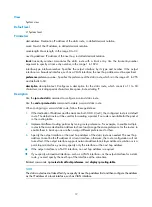
19
View
System view
Default level
2: System level
Parameters
dest-address
: Destination IP address of the static route, in dotted decimal notation.
mask
: Mast of the IP address, in dotted decimal notation.
mask-length
: Mask length, in the range 0 to 32.
next-hop-address
: IP address of the next hop, in dotted decimal notation.
track
track-entry-number
: Associates the static route with a track entry. Use the
track-entry-number
argument
to specify a track entry number, in the range 1 to 1024.
interface-type interface-number
: Specifies the output interface by its type and number. If the output
interface is a broadcast interface, such as a VLAN interface, the next hop address must be specified.
preference
preference-value
: Specifies the preference of the static route, which is in the range of 1 to 255
and defaults to 60.
description
description-text
: Configures a description for the static route, which consists of 1 to 60
characters, including special characters like space, but excluding
?
.
Description
Use the
ip route-static
command to configure a unicast static route.
Use the
undo ip route-static
command to delete a unicast static route.
When configuring a unicast static route, follow these guidelines:
1.
If the destination IP address and the mask are both 0.0.0.0 (or 0), the configured route is a default
route. The default route will be used for forwarding a packet if no route is available for the packet
in the routing table.
2.
Implement different routing policies by tuning route preference. For example, to enable multiple
routes to the same destination address to share load, assign the same preference for the routes; to
enable them to back up one another, assign different preferences for them.
3.
Specify the output interface or the next hop address of the static route as needed. The next hop
address cannot be the IP address of a local interface; otherwise, the route configuration will not
take effect. If the output interface supports network address-to-link layer address resolution or is a
point-to-point interface, you may specify only the interface or the next hop address.
•
If the output interface is a Null 0 interface, no next hop address is required.
•
If you specify a broadcast interface—such as a VLAN interface—as the output interface for a static
route, you must specify the next hop of the interface at the same time.
Related commands:
ip route-static default-preference
and
display ip routing-table
.
NOTE:
The static route does not take effect if you specify its next hop address first and then configure the address
as the IP address of a local interface, such as VLAN interface.



















